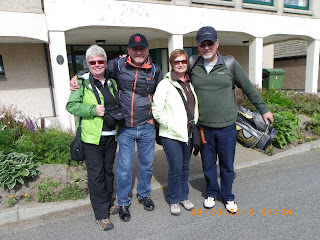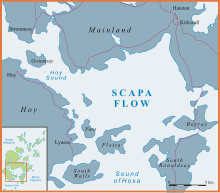Arriving at Stromness was a highlight for me, well all of us and especially Ann! Finally, The Orkney, for real. I had been looking forward to this part of our trip for months. I have some kind of romantic vision of remote Scottish Islands (and Highlands) that may stem from books I have read and of course meeting Ann's friend was much anticipated.
 |
| Disembarking Hamnavoe Ferry |
Alton, Ann's "kindergarten boyfriend" met us as planned at the ferry depot in Stromness with a car more than big enough to hold all our luggage and golf clubs. See, they do have cars this big in Scotland! Alton and Ann had know each other in Kincardine when they were kids in Kindergarten and have kept in touch over the years. She saw him about 8 years ago when he came with his Dad to visit so of course when we planned this trip to Scotland we had to visit him in Orkney. Alton was a wonderful host and tour guide and made sure we were well looked after.
Before depositing us at Ashleigh our B and B in Dounby, not far from Stromness, he took us on a short driving tour helping us to get our bearings. We were impressed with his driving skills. Having timidly driven ourselves around on the wrong side of the road for several days this seemed like breakneck speed! When we drove through the main street of Stromness we couldn't help but gasp as Alton manoeuvred us through tight turns only inches from store fronts and pedestrians. We knew we would avoid this at all costs when driving ourselves! No pictures...I was too terrified to get the camera out. It's a bit odd...even when you are on the rural roads they are so narrow that the driving is harrowing at times. Fun though and for some reason felt safer with a local at the wheel!
 |
| At low tide you can walk on this path over to the little Island. At high tide you can just see the walkway through the clear water. Lovely views all around. |
Ashleigh is a gorgeous home, built with a B and B in mind so our rooms were large with all the amenities you could want and an idyllic view of rural Orkney. Well, that's all Orkney is really. This was one of our most favourite accommodations. This gorgeous front room was full of Orkney ambiance and we sat there morning and evening enjoying the antics of the horses, and the docility of the sheep and cows.
 |
| Quite simple but luxurious at the same time. |
We didn't want to waste any time so after unloading we went to eat at Smithfield's restaurant/pub for a great lunch before heading to Skara Brae where we would begin to understand the history of "neolithic Orkney". Snapped some pictures on the way of the ever-present sheep, cows and stone walls.
 |
| Delicious! Sheep and so many lambs at this time of year. |
 |
| And the coos. (Scottish for cows) |
Two hundred metres from the neolithic excavation is Skaill House, a 400 year old "mansion" reflecting collections and history from all 12 of it's Lairds over the years. We decided to tour it first. Later it struck me how "young" this old house is compared to what we were to see next! And our century homes are infants in comparison.
 See what I mean? Skara Brae is over 5000 years old! It is astounding to think this kind of settlement may have a similar time frame to the Pyramids of Giza. Once we explored more of neolithic Orkney and an ancient site in Ireland I realized that the word "primitive" is a mis-nomer.
See what I mean? Skara Brae is over 5000 years old! It is astounding to think this kind of settlement may have a similar time frame to the Pyramids of Giza. Once we explored more of neolithic Orkney and an ancient site in Ireland I realized that the word "primitive" is a mis-nomer. These homes were actually quite modern considering their age. Imagine being settled enough to have storage shelves for your trinkets at that time! The fact that these homes had such amenities attest to
the advancement of the occupants. It is the best preserved prehistoric farming settlement in northern Europe. The village was originally built near a small inland loch and was buried by sand dunes over time, leaving it remarkably preserved. Unlike Pompeii the people were not forced from here by some catastrophic event. They lived here and moved on. The first house was discovered in 1850 after a huge storm stripped the dunes revealing it.
 |
| Looks pretty cozy. |
 |
| Erosion is now carefully monitored to preserve the site. |
Remarkably, we found our way back along tiny country roads (all paved as in most of Scotland and Ireland) to Ashleigh where we enjoyed a glass of wine in the sun room admiring the view. (Or maybe that was later!) Still lots of time left in the day since the sun won't be setting for a while. There are over 18 hours of daylight at this time of year. But Scotland is not as cold as it's latitudinal counterparts on this continent due to the warming influences of the gulf stream.
 |
| Dropping the boys off to golf. |
  |
| This does not do it justice but I managed to get this picture of the post office just before we almost ran into it. |
Now, for one of the highlights of our trip! Alton drove Ann and I around Scapa Flow.
 |
| One of many stunning views around Scapa Flow |

I am having trouble describing this myself so here is the cheat sheet from Wikipedia. There are many Norse connections in Orkney.
Scapa Flow (Old Norse: Skalpaflói—"bay of the long isthmus"[1]) is a body of water in the Orkney Islands, Scotland, United Kingdom, sheltered by the islands of Mainland, Graemsay, Burray,[2] South Ronaldsay and Hoy. It is about 312 square kilometres (120 sq mi). It has a shallow sandy bottom not deeper than 60 metres (200 ft) and most of it about 30 metres (98 ft) deep, and is one of the great natural harbours/anchorages of the world, with sufficient space to hold a number of navies. Viking ships anchored in Scapa Flow more than 1000 years ago, but it is best known as the site of the United Kingdom's chief naval base during World War I and World War II. The base was closed in 1956.
Who knew??
Along the way we stopped at the Italian Chapel a highly ornate Catholic Chapel built by Italian prisoners of war during World War 2. They were brought to desolate but strategic Orkney to construct the Churchill Barriers to prevent enemy access into Scapa Flow. The Chapel was built from minimal materials left over from the construction of the barriers but looking at it's beauty you can hardly believe it. Domenico Chiocchetti, a POW did most of the artwork inside and even when released remained to finish it. There has been a wonderful connection ever since. Alton is likely right when he says that if you were going to be a POW you would be better off in Orkney. Orkney is a special place and it must have really inspired anyone who visited no matter what the circumstances.
 |
| Inside the Italian Chapel |
The Churchill Barriers were a series of 4 causeways built in the 1940's to protect ships anchoring at Scapa Flow. In 1939 a German U Boat sunk the HMS Royal Oak, British Navy Battleship in the natural Harbour of Scapa Flow! When you see this area you can hardly believe it but again, as we explored more of Orkney we came to realize the historical significance of the waterways surrounding these Islands. Even back in the Norse days the ships passed and took refuge here on long journeys elsewhere. Now the barriers link the Orkney mainland to 4 smaller Islands and are used as roadways. You can still see the wreckage of the sunken ship.
How strange it was to find this totem pole the result of a unique joint project by the First Nation (Native Canadian Squamish) and the Orcadian Community. I have only read briefly about this project but it might be fun to look into. It makes a great picture!
Only one more picture of this lovely tour just for the beauty of it. This was one of a light house in the distance, perhaps from the view looking back at where we were! I have to admit, touring around Orkney I tended to lose my bearings. One gorgeous scene after another took my breath away. We would come over a hill, which didn't seem like a hill in the first place, and be faced with yet another unbelievable vista. Alton's explanations were amazing but hard to repeat. I think he laid off on his accent a bit to accommodate our untrained ears but everything he said was as interesting as the landscape. He has spent most of his life here and there is nothing like a local to give you all the good information. Golfing would have been fun but I wouldn't have missed this for the world!
Now we went to pick up the boys and we all went for a lovely dinner at an historical Hotel/Pub in Stromness near the Harbour. Believe it or not the day is not dark. But home to rest for another full one tomorrow.














No comments:
Post a Comment